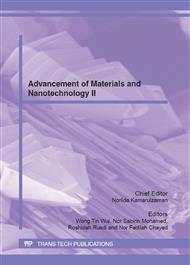p.348
p.355
p.359
p.367
p.373
p.379
p.387
p.393
p.401
Selective Synthesis of Glycerol Monoester with Heteropoly Acid as a New Catalyst
Abstract:
In this work, we were study the selective synthesis of GME from oleic acid and glycerol using two types of solid heteropoly acid catalysts, namely silicotungstic acid bulk (STAB) and STA-silica sol gel (STA-SG). The performance and selectivity of STAB and STA-SG in the esterification reaction have been investigated and compared to the sulphuric acid (H2SO4) as conventional homogeneous catalyst. The catalysts were then characterized their physical and chemical properties using BET, XRD, TEM and XPS. XPS analyses were shown a significant formation of W-O-Si, W-O-W and Si-O-Si bonding in STA-SG compared to that in STAB. The main spectra of O1s (90.74 %, 531.5 eV) followed by other O1s peak (9.26 %, 532.8 eV) were due to the presence of W-O-W and W-O-Si bonds, respectively. The STA-SG catalyst was found to be the more environmentally benign solid acid catalyst for the esterification reaction between oleic acid and glycerol due to its lower toxicity in terms of the relatively lower pH value (pH 3.7) than the STAB (pH 2.8). In addition, the ease of separation for STA-SG catalyst was attributed to its insoluble state in the product phase. The esterification products were then analysed by FTIR and HPLC. Both the H2SO4 and the STAB gave high conversion of 100 % and 98 %, but at a lower selectivity of GME with 81.6% and 89.9%, respectively. On the contrary, the STA-SG enabled a conversion of 94 %, but with a significantly higher GME selectivity of 95 % rendering it the more efficient solid acid catalyst.
Info:
Periodical:
Pages:
373-378
Citation:
Online since:
July 2012
Price:
Сopyright:
© 2012 Trans Tech Publications Ltd. All Rights Reserved
Share:
Citation:


